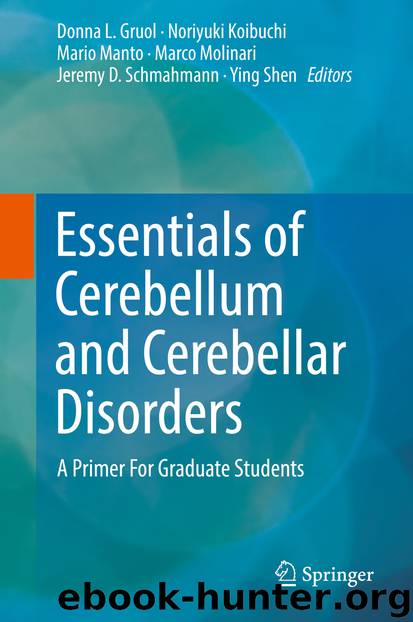Essentials of Cerebellum and Cerebellar Disorders by Donna L. Gruol Noriyuki Koibuchi Mario Manto Marco Molinari Jeremy D. Schmahmann & Ying Shen

Author:Donna L. Gruol, Noriyuki Koibuchi, Mario Manto, Marco Molinari, Jeremy D. Schmahmann & Ying Shen
Language: eng
Format: epub
Publisher: Springer International Publishing, Cham
45.2 LTD-Dependent Endocytosis of AMPA Receptors
Like LTD in other brain regions, PF-LTD is mediated by clathrin-dependent endocytosis of postsynaptic AMPA receptors. A key event triggering this is phosphorylation of the GluA2 subunit of AMPA receptors at serine 880 residue (GluA2-S880) by protein kinase Cα (PKC; Fig. 45.1b) (Matsuda et al. 2000; Xia et al. 2000). AMPA receptors are stabilized at synapses via their binding with glutamate interacting protein (GRIP). Phosphorylation at S880 drastically reduces GluA2’s affinity for GRIP, but not for protein interacting with C kinase 1 (PICK1), another anchoring protein that promotes AMPA receptor endocytosis. Therefore, inhibiting GluA2 interactions with GRIP or PICK1 impairs LTD induction (Matsuda et al. 2000; Xia et al. 2000; Steinberg et al. 2006).
Fig. 45.1LTD and its signaling cascades. (a) A typical diagram of LTD in a whole-cell patch-clamp recording. Excitatory post-synaptic currents (EPSCs; insets) of a Purkinje cell were elicited by stimulating parallel fibers (PFs) and their amplitudes are plotted against time. Conjunctive stimulations (CJ-stim) of PFs and a climbing fiber induced enduring reduction of PF-EPSCs. (b) A positive-feedback model together with NO and GluD2 pathways for LTD induction
Download
This site does not store any files on its server. We only index and link to content provided by other sites. Please contact the content providers to delete copyright contents if any and email us, we'll remove relevant links or contents immediately.
| Administration & Medicine Economics | Allied Health Professions |
| Basic Sciences | Dentistry |
| History | Medical Informatics |
| Medicine | Nursing |
| Pharmacology | Psychology |
| Research | Veterinary Medicine |
Tuesdays with Morrie by Mitch Albom(4729)
Yoga Anatomy by Kaminoff Leslie(4332)
Science and Development of Muscle Hypertrophy by Brad Schoenfeld(4103)
Bodyweight Strength Training: 12 Weeks to Build Muscle and Burn Fat by Jay Cardiello(3940)
Introduction to Kinesiology by Shirl J. Hoffman(3743)
How Music Works by David Byrne(3234)
Sapiens and Homo Deus by Yuval Noah Harari(3029)
The Plant Paradox by Dr. Steven R. Gundry M.D(2581)
Churchill by Paul Johnson(2544)
Insomniac City by Bill Hayes(2520)
Coroner's Journal by Louis Cataldie(2458)
Hashimoto's Protocol by Izabella Wentz PharmD(2350)
The Chimp Paradox by Peters Dr Steve(2340)
The Universe Inside You by Brian Clegg(2113)
Don't Look Behind You by Lois Duncan(2102)
The Immune System Recovery Plan by Susan Blum(2040)
The Hot Zone by Richard Preston(1995)
Endure by Alex Hutchinson(1993)
Woman: An Intimate Geography by Natalie Angier(1909)
